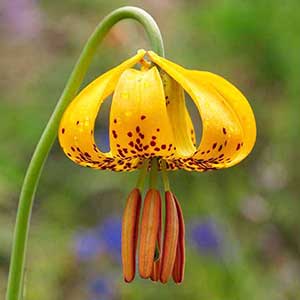Lilium columbianum
Lilium parvum
Columbia lily, Columbia tiger lily, Columbian lily, Oregon lily, tiger lily
alpine lily, Sierra tiger lily
variable, subrhizomatous to ± ovoid, 3.1–8.1 × 3.6–10.6 cm, 0.3–1.4 times taller than long;
scales 2–3(–5)-segmented, some unsegmented, longest 3.1–7.3 cm;
stem roots absent.
rhizomatous, unbranched, continuously scaly, 1.4–3.5 × 3.3–9.2 cm, 0.3–0.5 times taller than long;
scales (1–)2–3(–4)-segmented, longest 1.1–3.4 cm;
stem roots absent.
to 1.7 m, glaucous or not.
to 1.7 m. Buds rounded in cross section.
rounded in cross section.
in 1–9 whorls or partial whorls, 3–25 leaves per whorl, usually ascending, 1.7–15.7 × 0.4–4.7 cm, 2.4–7.4 times longer than wide;
blade weakly oblanceolate to obovate or ± elliptic, margins usually somewhat undulate, apex acute;
veins and margins ± smooth abaxially.
in 2–5 whorls or partial whorls, 3–13 leaves per whorl, ± horizontal and drooping at tips or ascending in sun, 4–15.1 × 0.5–4.4 cm, 2.3–10.8 times longer than wide;
blade ± elliptic, margins not undulate, apex acute, often narrowly so;
veins and margins ± smooth abaxially.
racemose, 1–25(–45)-flowered.
racemose, 1–26(–41)-flowered.
pendent to nodding, not fragrant;
perianth Turk’s-cap-shaped;
sepals and petals reflexed 2/5–1/2 along length from base, yellow or orange to occasionally red, with copious maroon spots, often darker and especially reddish abaxially, not distinctly clawed;
sepals not ridged abaxially, appearing wide for their length, 3.4–7.1 × 0.8–1.9 cm;
petals 3.5–6.9 × 0.8–1.9 cm;
stamens barely to moderately exserted;
filaments moderately spreading, diverging 10°–20° from axis;
anthers pale yellow to yellow, 0.5–1.3 cm;
pollen orange or yellow;
pistil 2.4–3.7 cm;
ovary 1.1–2.2 cm;
style green;
pedicel 2.8–20.2 cm.
± horizontal to ascending, sometimes slightly bilaterally symmetric, not fragrant;
perianth ± funnelform;
sepals and petals somewhat recurved 3/5–2/3 along length from base, not strongly reflexed, lower often less recurved than upper and forming landing platform, orange or yellowish proximally, darker (light orange, orange, red-orange, red, or rarely ± pinkish) on distal 2/5, occasionally uniformly light orange or rarely yellow, spotted dark purple-brown or maroon, often pale abaxially, not distinctly clawed;
sepals not ridged abaxially, noticeably wider than petals, 3.2–4.2 × 0.8–1.3 cm;
petals 3.2–4.2 × 0.6–1.2 cm;
stamens moderately exserted;
filaments moderately spreading, diverging 8°–17° from axis;
anthers pale yellow, orangish, or magenta, 0.3–0.8 cm;
pollen yellowish to red-orange;
pistil 2.3–3.7 cm;
ovary 0.8–1.4 cm;
style pale green;
pedicel 3.5–15.5 cm.
2.2–5.4 × 1.1–2 cm, 1.7–3.3 times longer than wide.
1.6–2.7 × 1.2–1.8 cm, 1.2–1.9 times longer than wide.
135–330.
90–132.
= 24.
= 24.
Lilium columbianum
Lilium parvum
The author citations often seen for this species derive from Baker (1874), who published the name as Lilium columbianum “Hanson in hort., Leichtlin”; this authority is given by various later writers as Hanson, or Baker, or Hanson ex Baker. However, Ducharte’s (1871) recapitulation of a letter from M. Leichtlin is apparently the first confirmed and valid publication of L. columbianum, and hence that citation is used here.
This widespread lily is rather variable. In California plants the stamens are considerably less exserted than those of plants found farther north. Lilium columbianum may intergrade with L. kelloggii along Highway 199 at the border between California and Oregon; these plants are slightly fragrant, the stamens moderately exserted, and the bulb scales unsegmented. Lilium columbianum hybridizes with L. pardalinum subspp. wigginsii and vollmeri, and extensively with L. occidentale in Oregon.
Lilium columbianum is pollinated primarily by rufous hummingbirds [Selasphorus rufus (J. F. Gmelin), family Trochilidae] and to a lesser extent by large butterflies, including the pale swallowtail (Papilio eurymedon Lucas, family Papilionidae).
Native Americans used Lilium columbianum bulbs as a food or peppery condiment, sometimes mixed with meat or salmon roe. For many, it was a staple food (J. Pojar and A. MacKinnon 1994).
(Discussion copyrighted by Flora of North America; reprinted with permission.)
At the lower elevations within its range, Lilium parvum tends to have clear yellow-orange flowers—a form that has been recognized as L. parvum var. crocatum���but perianth parts are redder apically at higher elevations in the Sierra Nevada. The pink-flowered form that is apparently localized at lower elevations in El Dorado County, California, is referred to informally as the ditch lily (O. H. Ballantyne 1983).
Lilium parvum hybridizes sporadically with L. pardalinum subsp. pardalinum at middle elevations (ca. 1200–1500 m) in the Sierra Nevada, resulting in variable swarms of plants with flowers that are intermediate in orientation, size, and perianth recurvature. Hybrids with Lilium kelleyanum are discussed under that species.
Lilium parvum is a pollination generalist visited by several species of hummingbirds (family Trochilidae), western tiger swallowtails (Papilio rutulus Lucas, family Papilionidae), pale swallowtails (P. eurymedon Lucas), and various bees (mostly family Apidae).
(Discussion copyrighted by Flora of North America; reprinted with permission.)
- Local floras:
BC,
CA,
OR,
WA
- Local Web sites:
CalFlora,
CalPhotos,
Flora NW,
PNW Herbaria,
Turner Photog.
WildflowerSearch
iNaturalist (observations)
USDA Plants Database
- LBJ Wildflower Center
- SEINet
- Plants of the World Online
- Encyclopedia of Life
- Wikipedia
- Google Image Search


